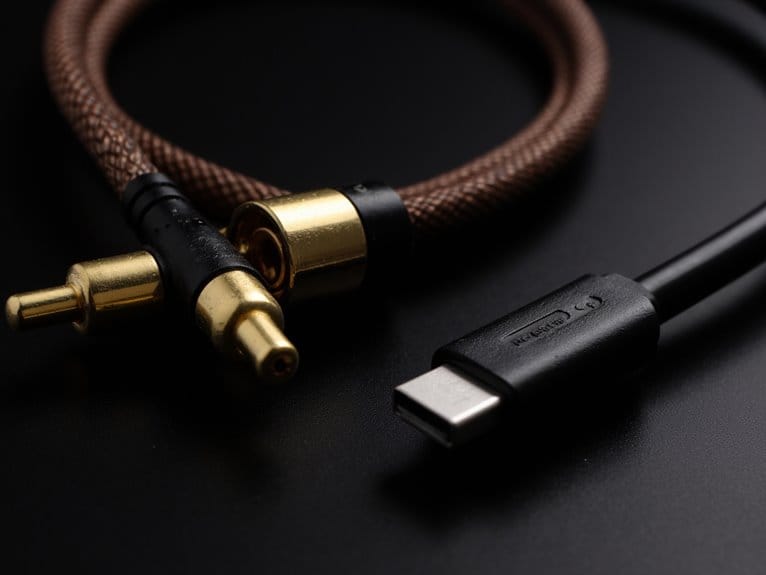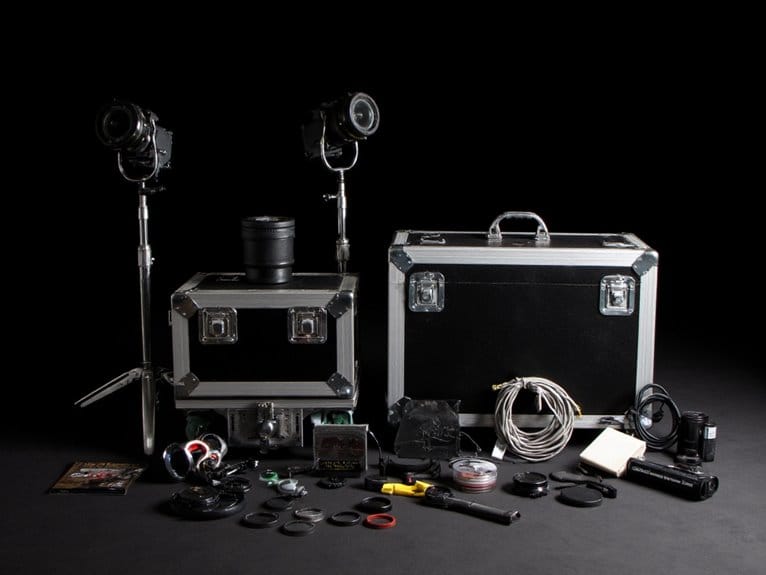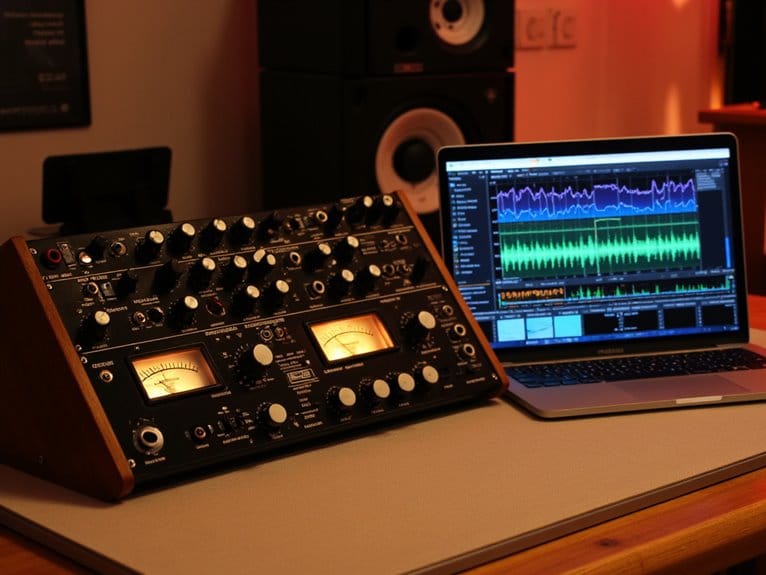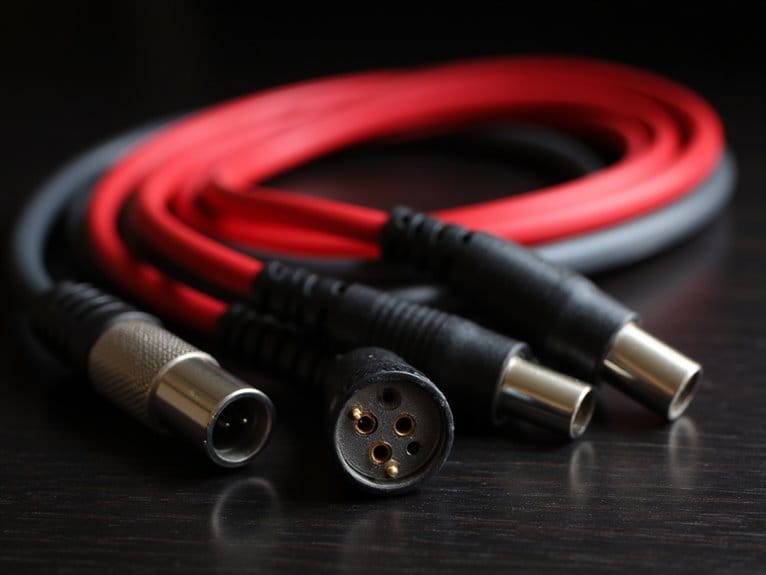Analog Vs Digital Audio Cables: Key Differences
You’ll find that analog cables transmit audio as continuous voltage waveforms through copper conductors, while digital cables encode sound using pulse-code modulation across controlled impedance lines. Analog systems can reach 100 meters but suffer progressive quality loss from interference, whereas digital cables maintain perfect fidelity through error correction, though they’re limited to shorter distances due to timing jitter concerns. The choice between these transmission methods greatly impacts your audio setup’s performance, compatibility requirements, and overall signal integrity.
We are supported by our audience. When you purchase through links on our site, we may earn an affiliate commission, at no extra cost for you. Learn more.
Notable Insights
- Analog cables transmit continuous voltage waveforms while digital cables use encoded data pulses requiring controlled impedance.
- Digital cables maintain perfect audio fidelity through error correction, while analog cables suffer progressive quality degradation.
- Analog cables typically reach 100 meters before signal loss, while digital USB cables max out at few meters.
- Same connectors like XLR and RCA can carry both analog and digital signals but require proper conversion.
- Environmental interference causes distortion in analog cables but complete dropouts or silence in digital connections.
Signal Transmission Methods and Technologies
When I first started diving into audio technology, I’ll admit the fundamental differences between analog and digital signal transmission seemed more confusing than they actually are.
You’ll find that analog systems transmit sound as continuous voltage waveforms that directly mirror the original audio, flowing through standard cables like RCA or XLR connections.
Digital transmission, however, uses signal encoding methods like pulse-code modulation to convert sound into binary data streams, requiring specialized cables such as optical Toslink or USB interfaces.
Digital systems convert audio into binary data through pulse-code modulation, transmitting via specialized cables like Toslink or USB.
The processing technologies differ considerably too—analog relies on passive circuitry with transformers and resistors to shape signals, while digital systems employ programmable hardware that enables advanced manipulations like noise reduction and equalization with remarkable precision. Digital audio’s precise signal processing capabilities make it particularly essential for professional recording studios and multimedia applications where accuracy is paramount.
Digital copies also provide indefinite duplication without any generation loss, which is a significant advantage over analog formats that degrade with each transfer.
Cable Construction and Distance Limitations
Now that we’ve covered how signals travel through different transmission methods, the physical construction of these cables becomes the determining factor in how well they’ll perform in your setup.
Analog cables typically use copper conductors arranged in twisted pairs or star-quad cable geometry, which provides balanced signal paths that reject noise more effectively than simple two-wire designs.
Digital cables require controlled impedance transmission lines, usually 75 or 110 ohms depending on format, with precise conductor spacing and specialized insulation materials to minimize signal reflections.
While analog cables can handle runs up to 100 meters before experiencing noticeable signal degradation, digital cables vary dramatically—USB maxes out at a few meters, but AES/EBU coaxial can reach 100 meters, and optical cables extend even further.
Digital cables may develop varying source impedances when used at lengths over 15 meters, which can significantly impact signal integrity and transmission line performance.
Frequency Response and Bandwidth Characteristics
One fundamental difference I’ve observed between analog and digital cables lies in how they handle frequency content, where analog cables must faithfully transmit continuous waveforms across the entire audible spectrum up to 20 kHz, while digital cables focus on preserving much higher frequencies in the MHz range that represent encoded data pulses rather than actual sound.
Analog cables preserve continuous waveforms up to 20 kHz while digital cables maintain MHz frequencies for encoded data transmission.
When you’re evaluating frequency response and bandwidth limitations, several critical factors demand your attention:
- Analog cables struggle with high-frequency attenuation that’ll rob your music of sparkle and detail.
- Digital cables face timing jitter that transforms pristine recordings into harsh, lifeless reproductions.
- Impedance mismatches create reflections that brutally distort your digital signal integrity.
- Cable resonances destroy the harmonic content essential for accurate data recovery.
- Distance limitations impose harsh penalties on both analog warmth and digital precision.
Compatibility and Interchangeability Options
Beyond these frequency and bandwidth considerations, compatibility issues present perhaps the most confusing challenge I encounter when helping people navigate cable selection, since many connectors look identical but carry completely different signal types that won’t work together without proper conversion.
You’ll find that RCA connectors can handle both analog audio and digital S/PDIF signals, while XLR cables work for analog balanced audio or digital AES/EBU formats, but the connector standards alone don’t guarantee compatibility.
I always emphasize checking your device specifications carefully, because physical connection doesn’t equal functional operation. You can’t simply swap analog cables for digital ones without proper DACs or ADCs handling the conversion, and attempting incompatible connections typically results in silence or corrupted audio rather than successful signal transfer.
When connecting microphones to recording equipment, you’ll also need to consider whether your audio interface provides the necessary phantom power for condenser microphones, as this 48V requirement affects both cable selection and equipment compatibility. Understanding dual connectivity options becomes essential when working with microphones that support both USB and XLR connections for maximum versatility.
Noise Immunity and Audio Quality Considerations
While connector compatibility might seem like the biggest hurdle in cable selection, I’ve found that understanding noise immunity differences between analog and digital cables often determines whether you’ll achieve professional-quality audio or struggle with frustrating interference issues.
Analog limitations become apparent when electrical interference gradually degrades your signal quality, creating unwanted distortion that compounds over longer cable runs, whereas digital advantages shine through binary transmission that either works perfectly or fails completely.
Consider these essential noise immunity factors:
- Analog cables suffer progressive quality loss as interference accumulates throughout the signal chain
- Digital cables maintain pristine accuracy through error-correcting protocols that preserve original audio fidelity
- Shielding requirements differ dramatically, with analog needing superior electromagnetic protection while digital tolerates simpler construction
- Environmental noise affects each type differently, causing analog distortion versus digital dropouts
- Professional installations demand understanding these fundamental transmission differences for ideal results
Quality DI boxes with ground lift switches effectively eliminate ground loop interference that commonly plagues analog signal chains, demonstrating the importance of proper analog signal handling.
Professional audio interfaces with zero-latency monitoring capabilities bypass many digital processing delays, allowing real-time signal monitoring through hardware-based routing that circumvents the computer’s audio processing chain entirely.
Frequently Asked Questions
Which Cable Type Is More Cost-Effective for Home Studio Setups?
You’ll find digital cables more cost-effective since they don’t require expensive shielding like analog benefits from. Digital drawbacks are minimal – cheap digital cables perform similarly to pricier ones, maximizing your studio budget efficiency.
Do Analog Cables Require Special Storage or Handling Conditions?
You’ll need proper storage for analog cables to protect cable insulation from moisture and temperature extremes. Use over-under wrapping, avoid tight coiling, and separate from power cables to prevent signal interference.
Can Weather or Humidity Affect Cable Performance Differently?
Weather impact varies greatly between cable types, with humidity effects causing immediate signal degradation in analog cables through moisture absorption and corrosion, while you’ll notice digital cables resist minor interference better.
Which Cable Type Lasts Longer Before Needing Replacement?
When comparing cable longevity, you’ll find digital cables typically outlast analog ones. This durability comparison shows digital cables resist signal degradation better, while analog cables suffer from interference and connector corrosion, requiring more frequent replacement.
Are There Specific Brands Recommended for Professional Recording Studios?
For professional studios, you’ll want cable brands like Sommer Cable, Studio Connections, and Neutrik/Rean that meet demanding studio requirements for signal integrity, durability, and reliability in critical recording environments.
On a final note
When you’re choosing between analog and digital audio cables, you’ll find that each serves distinct purposes in your audio setup. While analog cables offer simplicity and universal compatibility, digital cables provide superior noise immunity and support for high-resolution formats. Your decision should depend on your equipment, distance requirements, and quality expectations. Don’t overthink it—match the cable type to your gear’s connections and you’ll achieve excellent results.





